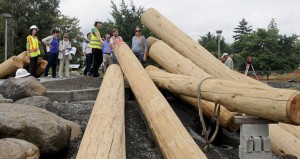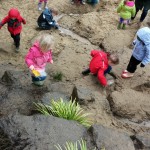Nature Play in the Oregon Daily Journal of Commerce
The Oregon DJC recently published this article about local nature play projects. It is nice to see the concept getting some good press. I like that the author used a lot of quotes!

Sandra Burtzos (gesturing, fifth from left), a Portland Parks & Recreation capital project manager, points out a climbing log feature while leading a tour of a nature play area under construction at Westmoreland Park in Southeast Portland. (You can see me and my pregnant belly on the far right!)
A movement to reconnect children with nature is reshaping playground design throughout the Portland-metro region and Oregon.
More public and private clients are requesting nature-based playgrounds that replace metal or plastic slides, swing sets and play structures with boulders, logs, sand and plants, Portland-area landscape architects say.
“Just about every client is talking about it,” said Mike Zilis, a principal with Portland-based landscape architecture firm Walker Macy. “It’s the new thing.”
“Nature play” or “playscape” playgrounds are gaining momentum as parents, teachers, park officials and landscape architects seek ways to encourage children to unplug from electronic devices, go outside and experience nature, said Ben Johnson, an associate with the Portland-based landscape architecture firm GreenWorks.
“It’s coming from multiple angles,” he said. “The design community, the park-planning community as well as the users are interested in it.”
Portland Parks & Recreation, Metro and Oregon State Parks have pilot nature play areas that are completed or under construction, with plans to build more.
Portland-area landscape architects also have designed natural playgrounds that range from completely natural settings to a hybrid of nature play elements and traditional playground equipment for schools, childcare centers, children’s museums and zoos.
Designing natural playgrounds takes a more custom approach than a traditional playground, which typically involves choosing equipment from a catalog, landscape architects say. Because there are no set safety standards for nature play, designers are tasked with translating standards written for traditional play structures to those made from natural materials.
Wood and other natural materials deteriorate faster, so maintenance is a large consideration in the design process. Procuring raw logs, boulders and other natural components for nature play projects can also be trickier. Plants are often chosen for their hardiness against trampling or potential for children to interact with them, such as picking the flowers, leaves or shoots.
A $1 million project under construction to replace the deteriorating and frequently flooded playground at Westmoreland Park in Southeast Portland will pilot the nature play approach, said Sandra Burtzos, a Portland Parks & Recreation capital project manager. The pilot project is a response to community feedback and Portland Parks & Recreation officials are considering similar projects at other city parks, she said.
“We had been getting requests,” Burtzos said. “There are a lot of community members that know about (nature play) and (want) it.”
GreenWorks designed the Westmoreland Park playground to feature large climbing logs, a sandy area and water channel. The aim is to entice children to play with and manipulate the sand, water and other natural elements in the playground, Johnson said.
“This whole nature play movement is trying to step back and create space where kids can interact with their environment in ways that are fun,” he said. “If we can create their play areas more naturally we can all agree that’s a good thing.”
A desire to find new ways to get children outdoors led to the Oregon State Parks system’s first nature playground at Silver Falls State Park near Silverton, said Steve Janiszewski, operations support manager for the Valleys Region of the Oregon Parks and Recreation Department. Oregon State Parks also has been instrumental in supporting the Oregon Nature Play Initiative, a group of landscape architects and park and recreation officials that supports and promotes natural play projects in the state.
In May, state park officials officially celebrated the opening of the Silver Falls Nature Play Area, also designed by GreenWorks. The increasingly frequented playground uses logs and other natural materials that were procured from the park and has different animal-themed areas, including a bird section with giant bird nests that children can climb into.
“People are seeing it and playing on it and telling their friends,” Janiszewski said. “It’s taking off, and I think we’ll build another one in a year or two.”
Portland landscape architect Michelle Mathis, designed the Silver Falls Nature Play Area while still working for GreenWorks. About a year and half ago, she felt confident enough with a surge nature play projects to start her own firm, Learning Landscapes Design, which specializes in designing nature-based playgrounds.
“All of the (requests for proposals) have nature playgrounds in them. It’s sort of a tipping point,” Mathis said. “I think people are noticing they’re getting more value out of nature play.”
Learning Landscapes Design’s recent projects include a planned nature playground at Metro’s Oxbow Regional Park in Gresham. It will be Metro’s second nature play area after a group of rangers led an effort to replace an aging playground at Blue Lake Regional Park in Fairview with one built from natural materials.
Designing a nature playground involves more careful safety inspections than selecting manufactured playground equipment that comes with a safety rating, but the added room for creativity is worth it, Mathis said.
“I just think it’s more fun. It’s just a broader range of what you can offer kids,” she said. “The fun of nature play is the distinctive piece of it. It does make the place more dynamic.”
Walker Macy is in the early stages of designing a nature play area for the planned Orenco Woods Nature Park in Hillsboro. The playground will engage children in a different way than a traditional play structure, Zilis said.
“I think the kids are really attracted to it because many of them have seen a standard playground,” he said. “This is a more intriguing way to have fun… It’s an opportunity to use imagination. To me, that’s the real crux of it. You’re asking kids to be kids. You’re saying, ‘Here’s an interesting place, make a game,’ and they do.”





This is a great article to shine more light on natural playgrounds. It’s fun to see these ideas becoming reality in finished projects where kids love to play and learn. (The pregnant belly is working on becoming a finished project as well!) Thanks for sharing!